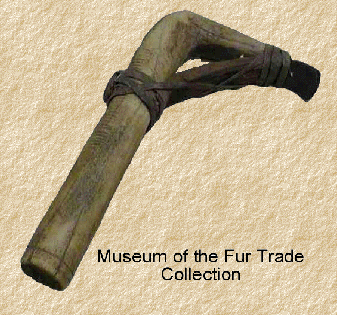Subject Guide

Mountain West
Malachite’s Big Hole
Preparing Robes and Hides:
While he was staying at Fort Union in 1852, Rudolph Kurz made the following observations about preparing robes and hides (Reference).
“When Madame David came to get "le dur" from me so that she might improve some robes Mr. Denig [the factor] thought too imperfectly prepared for market, I could not understand for a long while what "le dur" could mean. I was conducted by her to the meat house, where she pointed out the liver. This organ, also the brain of deer, or in the case of emergency, fat of any sort, tallow, etc., are all used to soften hides. One woman dresses a buffalo hide in 3 or 4 days just as well, makes the skin just as soft and durable, as our leather dressers do in 6 months. First of all, they stretch the raw hide on the ground and fasten it down with pegs or wooden pins, and with some sharp instrument, or a piece of bone perhaps, they scrape off every particle of flesh, which is eagerly devoured by the hungry dogs. If the skin is not to be dressed until later they leave it spread in the air to dry until it becomes quite hard. If, on the other hand, they intend to prepare the robe at once, they rub the hide for one entire day with liver, fat, or the brain of a deer to soften the skin, leave it 2 or 3 days (according to the season or extreme temperature) until the grease soaks in, then they dry it at a slow fire, constantly beating or rubbing it meanwhile with a stone until it becomes uniformly soft and pliable. This rubbing is of the greatest importance in the dressing of skins after Indian fashion.
As soon as the hide has been prepared in the manner described above and is quite dry they begin the fatiguing process of rubbing it around a taut rope of horsehair or braided leather to make it smooth; then it oftentimes receives a final polish with pumice stone. Such work is most burdensome from start to finish; even the scraping of the hides has to be done in a stooped position that is very fatiguing. As the brain of a deer is finer and more rare than liver or tallow, it is used primarily in the preparation of deerskins (except skins of elk). Hides of deer are placed in the final stage of preparation over a slow fire covered with green sprays of sumac and smoked; owing to this process they suffer less injury from water, they become golden brown in color, and retain for quite a while the smell of smoke, which repels mosquitoes and moths.
◊◊

"The usual mode of dressing skins, prevalent in this country among both Indians and whites, is very simple in its details and is easily practised.
